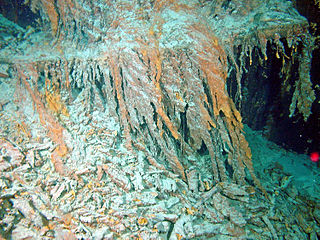The halophiles, named after the Greek word for "salt-loving", are extremophiles that thrive in high salt concentrations. While most halophiles are classified into the domain Archaea, there are also bacterial halophiles and some eukaryotic species, such as the alga Dunaliella salina and fungus Wallemia ichthyophaga. Some well-known species give off a red color from carotenoid compounds, notably bacteriorhodopsin. Halophiles can be found in water bodies with salt concentration more than five times greater than that of the ocean, such as the Great Salt Lake in Utah, Owens Lake in California, the Urmia Lake in Iran, the Dead Sea, and in evaporation ponds. They are theorized to be a possible candidate for extremophiles living in the salty subsurface water ocean of Jupiter's Europa and other similar moons.

Halomonadaceae is a family of halophilic Proteobacteria.

Ectoine is a natural compound found in several species of bacteria. It is a compatible solute which serves as a protective substance by acting as an osmolyte and thus helps organisms survive extreme osmotic stress. Ectoine is found in high concentrations in halophilic microorganisms and confers resistance towards salt and temperature stress. Ectoine was first identified in the microorganism Ectothiorhodospira halochloris, but has since been found in a wide range of Gram-negative and Gram-positive bacteria. Other species of bacteria in which ectoine was found include:
In enzymology, an ectoine synthase (EC 4.2.1.108) is an enzyme that catalyzes the chemical reaction
In enzymology, a diaminobutyrate-2-oxoglutarate transaminase is an enzyme that catalyzes the chemical reaction
Halomonas nitroreducens is a Gram-negative halophilic Proteobacteria, that is able to respire on nitrate and nitrite in anaerobiosis.

Halomonas titanicae is a gram-negative, halophilic species of proteobacteria which was discovered on rusticles recovered from the wreck of the RMS Titanic. Cristina Sánchez-Porro et al. first isolated the bacterium in 2010 from a sample of rusticle obtained from the RMS Titanic in 1991. One of the researchers, Henrietta Mann has estimated that the action of microbes like Halomonas titanicae may bring about the total deterioration of the Titanic by 2030. While the bacteria have been identified as a potential danger to oil rigs and other man-made objects in the deep sea, it also has the potential to be used in bioremediation to accelerate the decomposition of shipwrecks littering the ocean floor.
Deleya halophila is a salt-loving, gram-negative bacteria. It is known to habitat marine environments, solar salterns, saline soils, and salted food. The genus was named after J. De Ley, a noted biologist. Its type strain is CCM 3662.
Rhodothermus marinus is a species of bacteria. It is obligately aerobic, moderately halophilic, thermophilic, Gram-negative and rod-shaped, about 0.5 μm in diameter and 2-2.5 μm long.
Tetragenococcus muriaticus is a species of moderately halophilic lactic acid, histamine-producing bacteria. X-1 is the type strain of this species.
Desulfovibrio gracilis is a moderately halophilic bacteria. It is sulfate-reducing, mesophilic and motile. Its type strain is SRL6146T.
Chromohalobacter salexigens is a gram negative, oxidase and catalase positive, rod shaped, motile and moderately halophilic species of marine bacteria. It was isolated from Bonaire, Netherlands Antilles and from marine sponges of the Saint Martin's Island area of the Bay of Bengal, Bangladesh. Colonies are medium-sized, round and yellowish in color. The type strain is DSM 3043T. Its genome has been sequenced. It is a gamma-Proteobacterium, and as such, closely related to Pseudomonas and Escherichia coli.
Halomonas organivorans is a halophile able to degrade aromatic compounds. It's considered a potentially useful bacteria for decontamination of polluted saline habitats. Its type strain is G-16.1T.
Halomonas desiderata is an alkaliphilic, halotolerant and denitrifying bacterium first isolated from a municipal sewage works.
Halomonas anticariensis is a bacterium. It is strictly aerobic and because of its production of exopolysaccharides forms cream-coloured, mucoid colonies. FP35T is the type strain. Its genome has been sequenced.
Halomonas johnsoniae is a halophilic bacteria first isolated from the environment surrounding dialysis patients. It is closely related to H. magadiensis.
Halomonas hamiltonii is a halophilic bacteria first isolated from the environment surrounding dialysis patients. It is closely related to H. magadiensis.
Amorphus orientalis is a Gram-negative, moderately halophilic, aerobic and non-motile bacteria from the genus of Amorphus which has been isolated from sediments from a salt mine in Fenggang in China.
Halomonas meridiana is a bacterial species discovered in 1990 in the hypersaline lakes of Vestfold Hills, Antarctica.
Kushneria indalinina is a moderately halophilic, Gram-negative, aerobic and motile bacterium from the genus of Kushneria which has been isolated from a solar saltern from Cabo de Gata.


